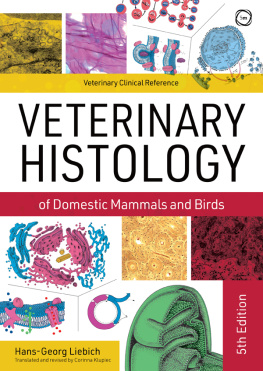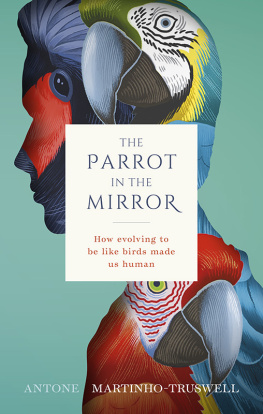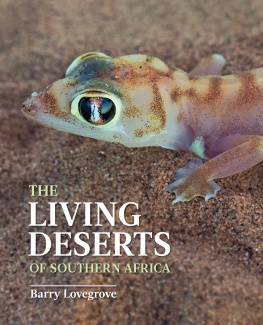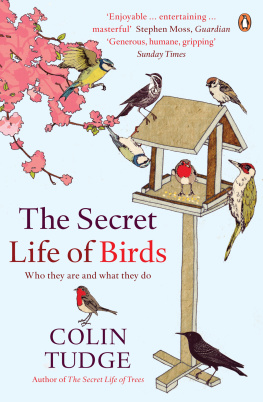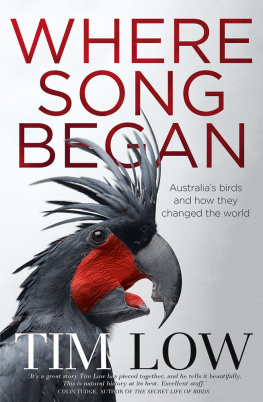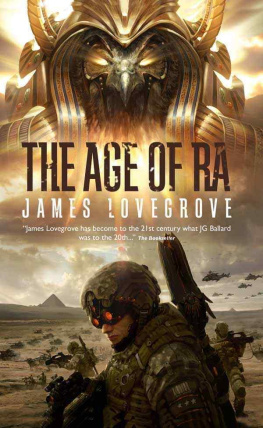FIRES OF LIFE
Fires of Life
Endothermy in Birds and Mammals
BARRY GORDON LOVEGROVE
FOREWORD BY ROGER S. SEYMOUR
Yale UNIVERSITY PRESS
NEW HAVEN AND LONDON
Published with assistance from the foundation established in memory of Calvin Chapin of the Class of 1788, Yale College.
Copyright 2019 by Barry Gordon Lovegrove.
All rights reserved.
This book may not be reproduced, in whole or in part, including illustrations, in any form (beyond that copying permitted by Sections 107 and 108 of the U.S. Copyright Law and except by reviewers for the public press), without written permission from the publishers.
Yale University Press books may be purchased in quantity for educational, business, or promotional use. For information, please e-mail (U.K. office).
Set in Electra LH type by Newgen North America, Austin, Texas.
Printed in the United States of America.
ISBN 978-0-300-22716-1 (hardcover : alk. paper)
Library of Congress Control Number: 2018960623
A catalogue record for this book is available from the British Library.
This paper meets the requirements of ANSI/NISO Z39.48-1992 (Permanence of Paper).
10 9 8 7 6 5 4 3 2 1
For Christopher
CONTENTS
by Roger S. Seymour
FOREWORD
You hold in your hand a unique book that I wish I had written. It considers the most important of evolutionary innovations: the appearance of highly active, warm-blooded species some 250300 million years ago. This development occurred in two lineages of vertebrates, in the mammals and in the archosaurs (ruling-reptiles) that gave rise to dinosaurs and birds. Because these groups were warm blooded, they have dominated the face of the earth right up to the present day. How these animals became warm blooded and what sort of conditions might have been responsible should interest everyone.
The tree of life has many branches. Most people are interested in the branches closest to human beings. Visitors to a zoo, for example, are generally more attracted to primates than to other vertebrates, and prefer mammals and birds over reptiles, amphibians, and fish. Invertebrate animals generate such little interest that they are hardly represented in zoos at all, despite being more numerous on earth. Part of the attractiveness of mammals and birds is that they are much more active and amusing than other animals. Their high levels of activity are a result of their being warm blooded, the common term that describes creatures with a body temperature higher than that of their surroundings. Cold-blooded vertebrates, including most living reptiles, amphibians, and fish, have low metabolic rates and body temperatures more or less the same as their environment. Physiologists call the warm-blooded groups endotherms (from the Greek words endon, meaning within, and therme, meaning heat), because a high metabolic rate inside the body is the principal origin of their body heat. The cold-blooded animals are ectotherms (Greek ektos, meaning outside), because their body heat is primarily determined by the environment around their bodies.
Endotherms and ectotherms are like chalk and cheese. Aside from being able to keep their body temperatures high, endotherms have metabolic rates some ten times greater than ectotherms, and consequently are able to be more active for longer periods and generate more power for subduing prey, and for defense. As the cost for this activity and endurance, they require about ten times as much food as ectotherms. This energy-expensive lifestyle is matched by the ability of endotherms to find food under cool conditions, when ectotherms cannot function. The high metabolic rate of endotherms allows some of them to travel long distances in search of food; ectotherms cannot. When the cost of obtaining food is greater than the energy contained in it, some endotherms, called heterotherms, drastically reduce their metabolic rates and enter a temporary state of torpor and hibernation. Conversely, some ectotherms, such as lizards, snakes, extremely active fish, and most flying insects, can increase their metabolic rates high enough to significantly raise their body temperatures.
Evolutionary physiologists such as Barry Lovegrove ask questions about the origin of endothermy among vertebrates. Because it is not possible to take direct measurements of the metabolic rates and body temperatures of extinct animals, we are left to speculate on how and when the transition from ectothermy to endothermy occurred in evolutionary history. These conjectures are based on the patterns of endothermy in living mammals and birds, as well as the form and function of fossil species.
The evolution of endothermy has been the subject of many papers over the years, but this is the first book I know of that deals directly with mammals and birds on their own. The first chapters of the book consider the fossil evidence and the lineages of birds and mammals, giving an idea of the circumstances and environments that may have played a part in the appearance of endothermy. The middle chapters are case studies of extant mammals that offer insight into the kind of early mammal that Barry envisions. These chapters record highly personal research experiences, most interestingly in hot and humid Madagascar, where tenrecs apparently do not require endothermy. The final chapters return to the physiology of endothermy and temperature regulation, and include several hypotheses for single causes of the evolution of endothermy.
Barry Lovegrove is an expert on the subject of endothermy in living species, and he lives near one of the most prolific sources of early mammal fossils. I have followed Barrys research for decades, from his initial work on subterranean mole rats from southern Africa. These social animals form colonies and feed entirely underground, burrowing blindly through the soil until they encounter plant tubers that they strategically use for food. Barry measured the energy cost of burrowing and compared it with the energy gain from food, yielding one of the most elegant studies in energy economics in the ecological literature. I have presented this material as a model study in my course on environmental physiology for the past thirty years, because nothing beats it. Among Barrys other notable contributions, he introduced the concept that the variability in the metabolic rates of different species of mammals depends on body size, being most variable in the smallest and largest animals, and less so in the middle range of size. In the year 2000, he called this the bow-tie pattern, because the points on a graph were constrained at body sizes of about 350 grams, but flared out on either side, just like a bow tie. The name stuck. Craig White and I confirmed this pattern in 2004 through an analysis of more than six hundred species of mammals, although the reason for it remains elusive.
The effect of body size is apparent in every aspect of animal biology, not only physiology, but also anatomy, ecology, and behavior, and the effects are usually not proportional to body size. This book recognizes that the way ecophysiologists study the effect of body size is by plotting data on graphs with logarithmic axes, setting equations and statistics to the patterns, and then trying to decipher their meanings. One of the first physiologists to do this was Max Kleiber, who wrote a book in 1961 called The Fire of Life: An Introduction to Animal Energetics, which has been a touchstone for physiologists ever since. The title of the book you hold is an homage to Kleiber, but its content mercifully spares you the tedious analytical detail of allometric equations. Rather, Barry concentrates on the phenomenon of endothermy in relation to body size in a general sense.
Next page


